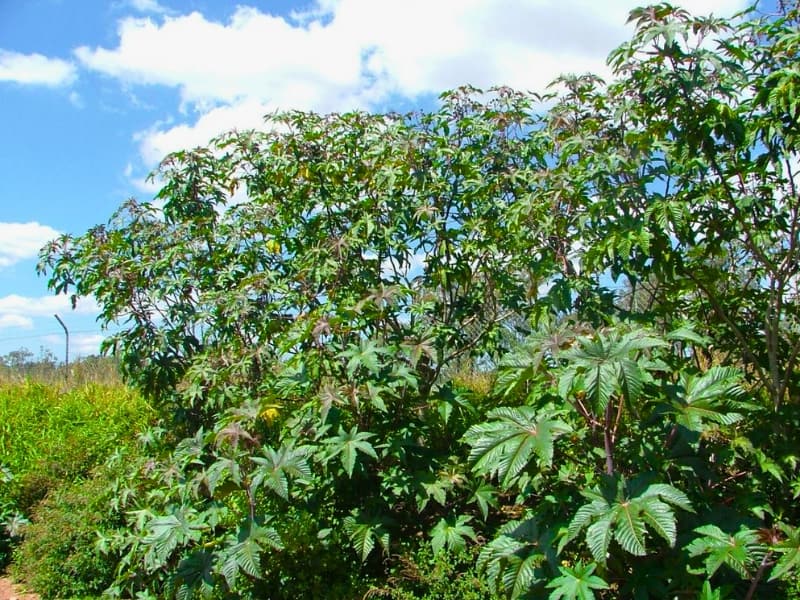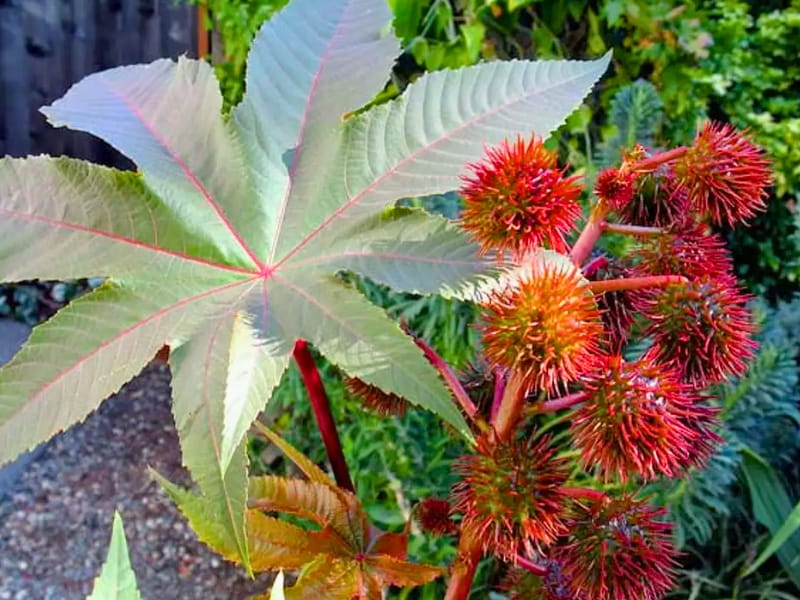Castor Oil Plant, also commonly known as Palma Christi, Castor Bean, or Ricinus communis (its botanical name), is a fast-growing, striking plant recognized for its large, palmate leaves and, unfortunately, its highly toxic seeds. This plant offers a unique blend of ornamental appeal and industrial applications, making it a fascinating subject for gardeners and researchers alike.
This guide will cover everything you need to know about Castor Oil Plant, from its cultivation to its uses and potential benefits, how to grow Castor Oil plant, and where you can buy castor oil seeds.

1. Castor Oil Plant: A Comprehensive Overview
The Castor Oil Plant ( Ricinus communis) is a species of flowering plant in the spurge family, Euphorbiaceae. It’s believed to be indigenous to the southeastern Mediterranean Basin, Eastern Africa, and India, but it’s widely naturalized in tropical and subtropical regions around the world. This plant is incredibly adaptable, thriving in a range of conditions, which contributes to its widespread distribution.
| Common Name | Castor Oil Plant, Castor Bean, Palma Christi, Wonder Tree |
| Botanical Name | Ricinus communis |
| Family | Euphorbiaceae (Spurge family) |
| Genus | Ricinus |
| Species | communis |
| Origin | Southeastern Mediterranean Basin, Eastern Africa, India |
| Native | Widely naturalized in tropical and subtropical regions; not native to any specific region currently. |
| Life Cycle | Perennial in tropical/subtropical climates; Annual in temperate climates. |
| Plant Type | Shrub or small tree (often grown as an annual) |
| Hardiness Zone | 9-11 (as a perennial; can be grown as an annual in all zones) |
| Sunlight | Full Sun (at least 6 hours of direct sunlight per day) |
| Maintenance | Low to Moderate |
| Water | Moderate; drought-tolerant once established, but prefers consistent moisture. |
| Drainage | Well-Drained (essential to prevent root rot) |
| Spacing | 3-6 feet apart (depending on variety and desired size) |
| Flowering Period | Summer to Fall (depending on climate and planting time) |
| Height | 6-15 feet (can reach up to 40 feet in ideal conditions) |
| Growth Rate | Fast |
| Flower Color | Greenish-yellow or reddish (inconspicuous, lacking petals) |
| Stem Color | Green, reddish-purple, or bronze (depending on variety) |
| Foliage Color | Green, reddish-purple, or bronze (depending on variety) |
| Leaf Shape | Palmate, with 5-12 deep lobes |
| Seed Pod Color | Green, red, or pink (depending on variety), spiny |
| Flower Benefit | Primarily grown for foliage and architectural interest; flowers are not showy. |
| Garden Style | Tropical, Container, Architectural, Specimen Plant |
| Uses | Ornamental, Industrial (castor oil production), Biodiesel (potential) |
| Soil pH | Slightly acidic to neutral (6.0-7.0) |
| Soil Type | Tolerant of a wide range, but prefers fertile, well-drained loam. |
| Propagation | Primarily by seed |
| Toxicity | Highly toxic seeds due to ricin. |
| Pest and Diseases | Generally pest and diseases resistant. |
The plant’s appearance is quite distinctive. It can grow as a large shrub or small tree, reaching heights of up to 40 feet in ideal conditions, although it’s more commonly seen at heights of 6-15 feet in cultivated settings. The leaves are large, glossy, and palmate, with 5-12 deep lobes, resembling a star. The leaf color can vary from a deep green to reddish-purple or bronze, adding to the plant’s ornamental value. The flowers are relatively inconspicuous, lacking petals, and are borne in dense inflorescences. The fruit is a spiny capsule containing large, mottled, bean-like seeds – the source of castor oil, but also the highly toxic compound ricin.
Historically, castor oil has been used for thousands of years. Ancient Egyptians used it as lamp oil and in medicinal preparations. Evidence of its use has also been found in ancient Greece and Rome. Today, its applications are incredibly diverse, ranging from industrial lubricants to cosmetics and pharmaceuticals.
2. Growing Castor Oil Plant: A Step-by-Step Guide
Growing Ricinus communis can be relatively easy, provided you understand its basic needs and take precautions due to its toxicity. Here’s a step-by-step guide:
- Seed Starting (Indoors):
- Timing: Start seeds indoors 6-8 weeks before the last expected frost.
- Soaking: Soak seeds in water for 24 hours to improve germination. This softens the hard seed coat.
- Potting Mix: Use a well-draining seed-starting mix.
- Planting Depth: Plant seeds 1 inch deep.
- Watering: Keep the soil consistently moist but not waterlogged.
- Temperature: Maintain a warm temperature, ideally around 70-80°F (21-27°C). A heat mat can be beneficial.
- Light: Once seedlings emerge, provide bright light. A sunny windowsill or grow lights are ideal.
- Transplanting (Outdoors):
- Timing: Transplant outdoors after the last frost, when the soil has warmed up.
- Hardening Off: Gradually acclimate seedlings to outdoor conditions over a week. This reduces transplant shock.
- Location: Choose a sunny location with well-drained soil. Castor oil plants tolerate a wide range of soil types but prefer fertile, slightly acidic soil.
- Spacing: Space plants 3-6 feet apart, depending on the variety and desired size.
- Planting: Dig a hole slightly larger than the root ball. Gently remove the seedling from its container and place it in the hole. Backfill with soil and water thoroughly.
- Outdoor Care:
- Watering: Water deeply and regularly, especially during dry periods. Castor oil plants are relatively drought-tolerant once established, but consistent moisture promotes optimal growth.
- Fertilizing: Apply a balanced fertilizer every 4-6 weeks during the growing season. A fertilizer with a higher phosphorus content can encourage flowering and seed production (if desired, but be mindful of the toxicity).
- Staking: Tall varieties may require staking to prevent them from toppling over in windy conditions.
- Pruning: Pruning is generally not necessary, but you can remove any dead or damaged leaves. If you want to control the plant’s size, you can prune it back in the spring.
- Pest and deceases Control: Generally, the plant has a great resistant to diseases and pest. But sometimes they might come under attack from spider mites.
- Seed Collection (with Caution):
- Maturity: Seed pods mature in late summer or fall. They will turn brown and dry.
- Harvesting: Wear gloves and eye protection when handling seed pods. Carefully cut the pods from the plant.
- Drying: Allow the pods to dry completely in a well-ventilated area.
- Extraction: Once dry, the pods will split open, releasing the seeds. Handle seeds with extreme care.
- Storage: Store seeds in a cool, dry, dark place, out of reach of children and pets. Clearly label the container as toxic.

3. The Many Uses of Castor Oil: From Industry to Medicine
Castor oil, extracted from the seeds of Ricinus communis, is a versatile substance with a wide range of applications. Its unique chemical composition, rich in ricinoleic acid, gives it properties that are valuable in various industries.
- Industrial Uses:
- Lubricants: Castor oil is an excellent lubricant, particularly in high-temperature and high-pressure applications. It’s used in jet engines, racing engines, and other specialized machinery. Its high viscosity and stability make it suitable for these demanding environments.
- Biodiesel: Castor oil can be used as a feedstock for biodiesel production. It has a high energy content and can be converted into a renewable fuel source.
- Plastics and Resins: Castor oil derivatives are used in the production of various plastics, resins, and coatings. They contribute to the flexibility, durability, and other properties of these materials.
- Paints and Varnishes: Castor oil is used as a drying oil in paints and varnishes. It helps to create a durable, glossy finish.
- Textiles: Castor oil is used in the textile industry as a dyeing agent and lubricant.
- Cosmetic and Personal Care Uses:
- Moisturizer: Castor oil is a highly effective emollient, meaning it helps to soften and hydrate the skin. It’s often found in lotions, creams, and balms.
- Hair Care: Castor oil is believed to promote hair growth and improve hair health. It’s often used in hair masks, conditioners, and serums. However, scientific evidence supporting these claims is limited.
- Makeup Remover: Castor oil can be used to remove makeup, even waterproof mascara.
- Soap Making: Castor oil is a common ingredient in soap making. It contributes to the lather and moisturizing properties of the soap.
- Medicinal Uses (Historical and Modern):
- Laxative: Castor oil is a powerful stimulant laxative. It works by irritating the lining of the intestines, causing them to contract and expel their contents. However, it should only be used under the guidance of a healthcare professional due to its potency and potential side effects.
- Labor Induction: Historically, castor oil has been used to induce labor. However, this practice is controversial and potentially dangerous, and should only be considered under strict medical supervision.
- Anti-inflammatory: Ricinoleic acid, the main component of castor oil, has demonstrated anti-inflammatory properties in some studies. This suggests potential applications for treating inflammatory conditions, but more research is needed.
- Antimicrobial: Castor oil has shown some antimicrobial activity against certain bacteria and fungi in laboratory studies. (Source: National Library of Medicine). https://pubmed.ncbi.nlm.nih.gov/23061887/
- Wound Healing: Some traditional medicine practices use castor oil to promote wound healing.
4. The Toxicity of Castor Oil Plant: Ricin and its Effects
The seeds of the Castor Oil Plant contain ricin, one of the most potent toxins known to exist. Ricin is a type of protein called a ribosome-inactivating protein (RIP). It works by inhibiting protein synthesis within cells, leading to cell death. Even a small amount of ricin can be lethal.
- Routes of Exposure:
- Ingestion: The most common route of exposure is through ingestion of the seeds. Chewing the seeds releases more ricin than swallowing them whole.
- Inhalation: Inhalation of ricin powder is also highly dangerous.
- Injection: Injection of ricin is the most potent route of exposure, but it’s less common.
- Symptoms of Ricin Poisoning:
- Ingestion: Symptoms typically appear within a few hours to a day after ingestion. They can include nausea, vomiting, abdominal pain, diarrhea (often bloody), dehydration, low blood pressure, and organ damage.
- Inhalation: Symptoms can appear within hours and include respiratory distress, fever, cough, nausea, and chest tightness.
- Injection: Symptoms appear rapidly and include pain and swelling at the injection site, followed by systemic symptoms similar to those of ingestion and inhalation.
- Treatment:
- There is no specific antidote for ricin poisoning.
- Treatment focuses on supportive care, such as managing symptoms, providing fluids, and supporting organ function.
- Early medical intervention is crucial.
- Prevention:
- Keep out of reach of children and pets.
- Wear gloves and eye protection when handling the plant, especially the seeds.
- Educate yourself and others about the dangers of the plant.
- Do not consume any part of the plant.
- If you suspect ricin poisoning, seek immediate medical attention. Contact your local poison control center or emergency services.
- Dispose of seeds, plant properly.

5. Castor Oil Plant Varieties: Choosing the Right One for Your Garden
While Ricinus communis is the species name, there are several cultivars and varieties that offer different aesthetic characteristics.
| Variety | Height (feet) | Leaf Color | Seed Pod Color | Notes |
| ‘Carmencita Pink’ | 6-8 | Bronze-red | Bright Pink | Popular for its vibrant pink seed pods and reddish foliage. |
| ‘Impala’ | 5-6 | Green to reddish-purple | Red | Compact variety, suitable for smaller gardens. |
| ‘Zanzibarensis’ | 10-15 | Large, green | Green | Very large variety with massive leaves, creating a tropical look. |
| ‘Gibsonii’ | 6-8 | Deep red-purple | Red | Known for its striking dark foliage. |
| ‘Sanguineus’ | 8-12 | Red | Red | Red stems and leaves. |
6. Frequently Asked Questions about Castor Oil Plant
- Is castor oil safe to use? Castor oil itself is generally considered safe for external use when used as directed. However, the seeds from which it’s derived are highly toxic. Never ingest castor oil without the guidance of a healthcare professional.
- Can I grow castor oil plant in a container? Yes, castor oil plants can be grown in containers. Choose a large pot (at least 15 gallons) with good drainage.
- Is castor oil plant an annual or a perennial? In tropical and subtropical climates, castor oil plant can be a perennial. In temperate climates with cold winters, it’s grown as an annual.
- Does castor oil plant repel moles? There’s anecdotal evidence that castor oil plants may repel moles, but there’s no strong scientific evidence to support this claim.
- How do I dispose of castor oil plant waste? Dispose of plant material, especially seeds, carefully. Double-bag the waste and place it in the trash. Do not compost it.
- What is the best time to sow Castor Oil Plant? The Best Time to sow Castor oil plant is when the danger of frost has passed
- What Type of soil do Castor Oil plant Prefers? Castor oil plant prefers a well-drained, fertile soil.
- How much spacing is required for Castor Oil plant? Provide adequate spacing between plants, typically 3 to 6 feet apart
- What is the required PH level of soil for Castor Oil plant? The soil PH should slightly be acidic to neutral.
- What is the Germination time of Castor Oil plant seed? Seeds typically germinate within 2 to 6 weeks

Leave a Reply